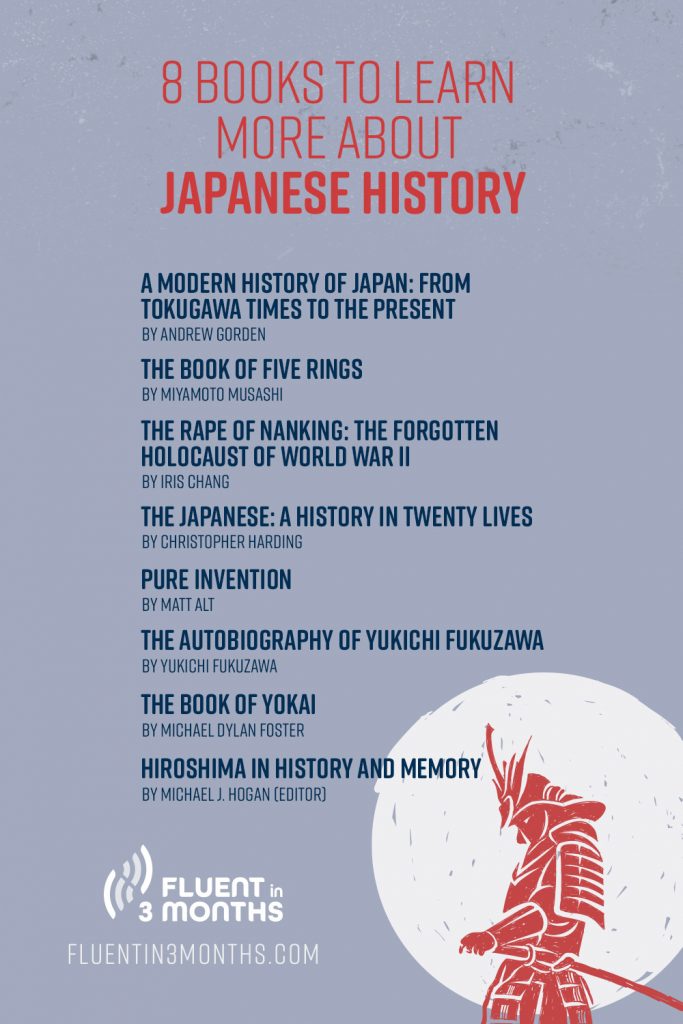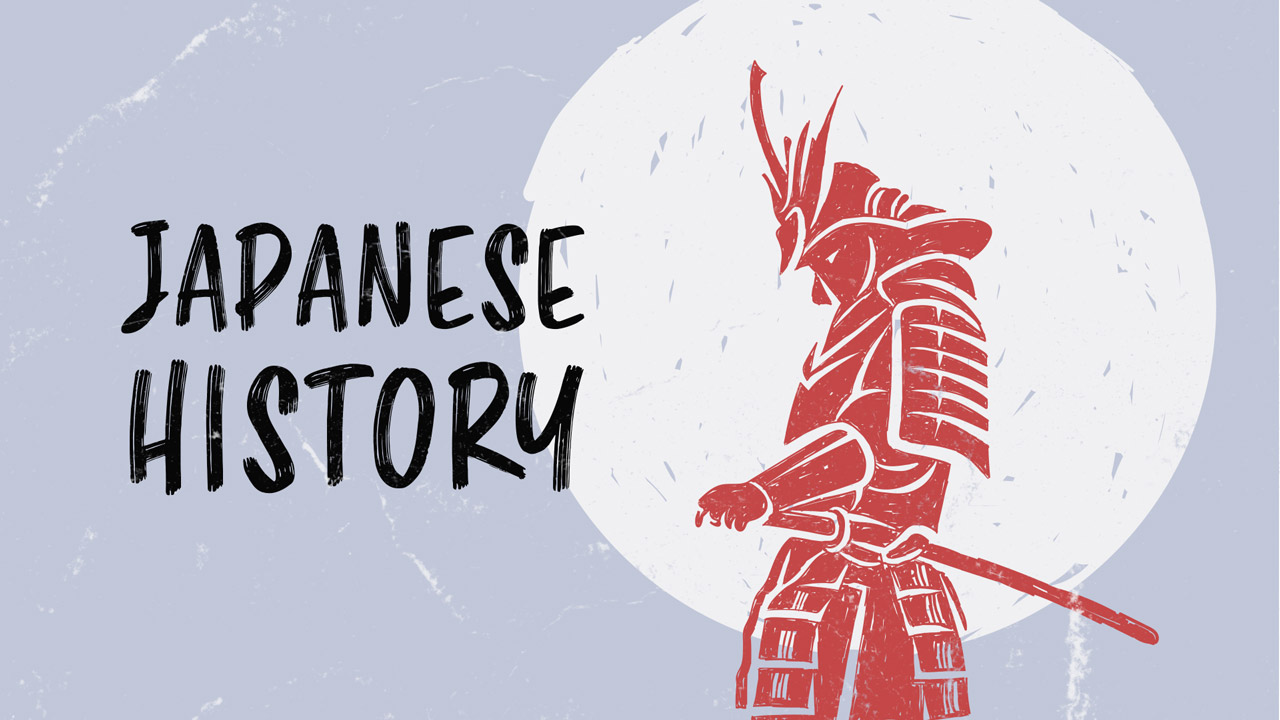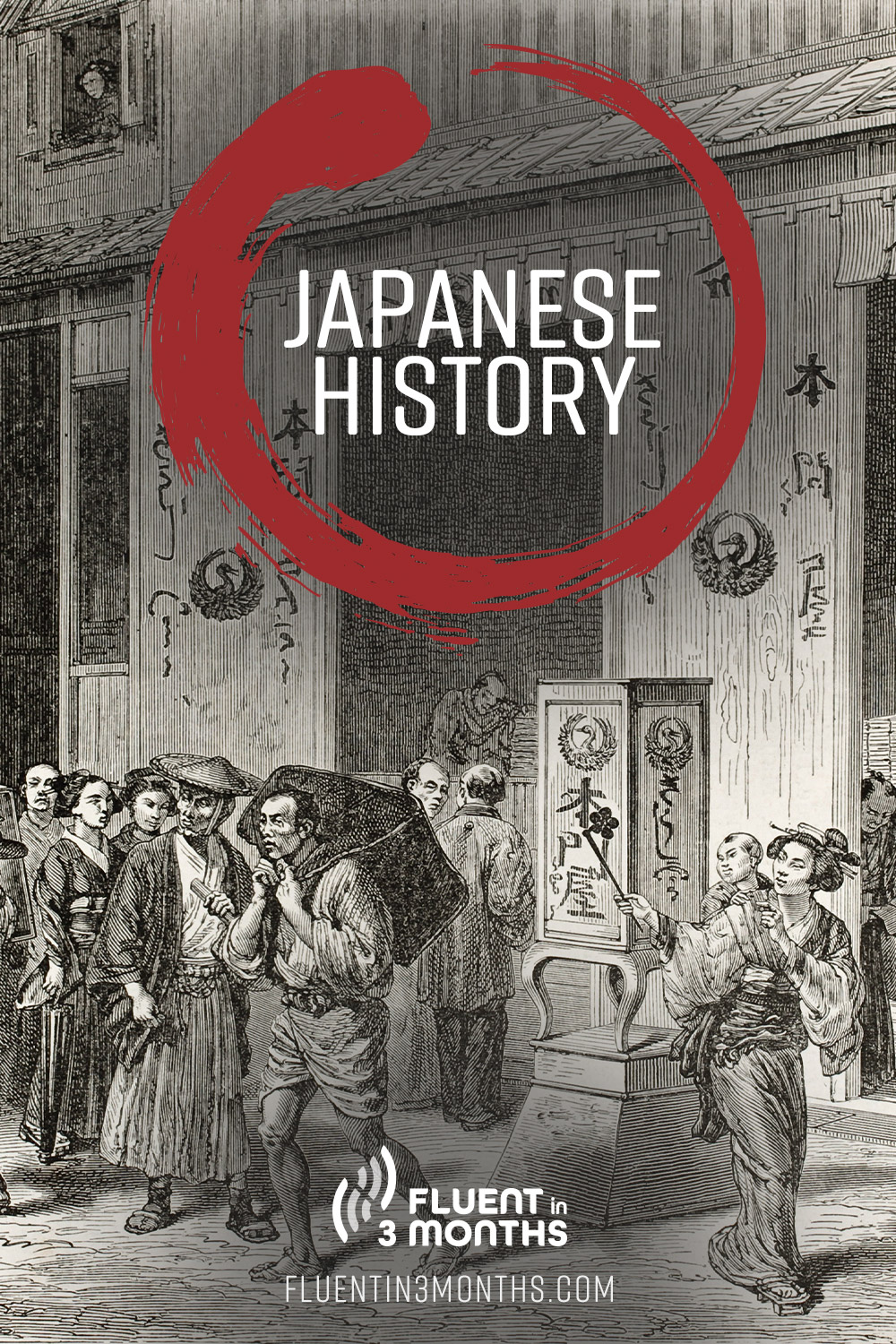Japanese History: The Beginner’s Guide
Japanese history is one of the most unique in the world. From samurai, ninja, and shoguns – there’s no shortage of things to learn.
Learning about Japanese history will give you a much deeper understanding of the culture and language. Stick around until the end of the post and I will reveal to you a couple of surprising ways in which history has shaped the Japanese culture you know!
Table of contents
- How to Say “History” in Japanese: 歴史, rekishi
- Japanese History: An Overview
- Japanese History Timeline
- Ancient Japan
- Asuka, Nara, and Heian Periods
- Feudal Japan: The Shogunate and Daimyou Era
- Modernization of Japan: Edo and Meiji Periods
- Japanese American History
- Japanese Brazilian History
- Japanese Language History
- Japanese History for Kids: Resources
- Japanese History Books to Learn More
- Bonus: Two Fun Facts About Japanese History in Japanese Modern Culture
- Japanese History Buff!
How to Say “History” in Japanese: 歴史, rekishi
First, let’s learn how to talk about the subject at hand in Japanese!
“History” in Japanese is 歴史, rekishi. This means all history but is often used to talk about history as a school subject or major.
If you want to be specific and talk about Japanese history, you can say 日本史, nipponshi.
Why nippon instead of nihon?
Nippon is the more honorific way to talk about Japan. This actually comes from Japanese empirical history! The Empire of Japan was called Dai Nippon Teikoku, so the name does have some mixed feelings.
The Imperial days of Japan aren’t looked upon fondly. So while nippon is often used to show patriotism and respect to the country, nihon has become increasingly used. But, as it stands right now, both are often used interchangeably.
Nihon is often used for adjectives or combined words, like 日本語, nihongo (nihon, “Japan” + go, “language” for “Japanese”). Nippon is often used for the country name itself or respectful/traditional situations, as with nipponshi.
Japanese History: An Overview
How far back does Japanese history go? Japan was settled about 35,000 years ago, in what is called the Paleolithic period.
So there are a lot of years to cover! I’m going to cover the highlights here so you can get an idea of what the history of Japan was like.
Japanese History Timeline
What is the history of Japan? What major events happened in Japan?
Well, Japan’s history is often broken down into various eras, periods of time where Japan was ruled by one emperor, shogun, or family. But there are also larger periods, such as ancient Japan, feudal Japan, and modern Japan.
Below you’ll find the periods broken down and eras grouped together by their larger time periods, with summaries of major events.
You may be wondering though: What was Japan called before? Japan has actually had many names!
Japan was originally called 倭 (wa) or 倭国 (wakoku), but the kanji 倭 meant “submissive.” So Japan changed the kanji to a different “wa,” 和, which means “peace.” It was then combined with 大, dai (“big”, “great”), to become 大和 which was read, Yamato.
So if you’ve ever heard Japanese food referred to as 和食, washoku – this is why it’s “wa” instead of nihonshoku!
Around the 7th century, Japan changed its name to 日本, nippon, meaning “Origin of the Sun.” That’s where “The Land of the Rising Sun” comes from.
Later, during the Meiji era, Japan became known as 大日本帝国 (dai nippon teikoku), the “Great Japan Empire.” It was known as this up until the end of World War II. Then it was known as Nippon, Nihon, or sometimes 大日本 (dainippon, “Great Japan”) or 日本国 (nipponkoku, “Country of Japan”).
The latter names are mostly used in governmental situations, though.
Ancient Japan
It was during this period that hunters and gatherers from mainlandf Asia crossed over to Japan.
The Joumon period, from 13,000 BCE to 1,000 BCE, was when those native to Japan began to settle down and begin to develop culturally. In fact, the pottery from this era is the oldest in the world and is quite complex. This is also when the ancestors of the Ainu people settled in the Hokkaido region of Japan.
Then during the Yayoi period, many common agricultural practices were brought to Japan from the Yayoi people in Asia. Rice farming began, and iron tools, silk, weaving, glassmaking, and more came to be.
It was during the Yayoi period, around 660 BCE, that Japan had its first Emperor, named Emperor Jimmu. But it wasn’t until around 250 CE that Japan became unified under leaders related to the Emperor’s bloodline.
During this time, Japan aimed for formal recognition from China, and there were likely clan wars to establish rule.
Asuka, Nara, and Heian Periods
The Asuka period (around 530 CE) was pivotal for much of what we see in Japanese culture today. At this time, Buddhism came to Japan from Korea. Confucianism ideology also became widespread in Japan due to its implementation by the ruling clans at the time.
It was during the Nara period we got the first two books in Japanese history: Nihon Shoki and Kojiki. They both tell of Japanese myths and traditions and have been crucial for historians to document ancient Japan.
Smallpox became an epidemic in Japan starting in 735 CE and killed a large portion of the Japanese population.
This started a chain reaction: Emperor Shoumu thought it was a curse because he wasn’t holy enough. This led to an increase in Buddhism, which led to a Buddhist monk named Doukyou trying to overthrow the Emperor with the help of Empress Shoutoku.
Then, the Heian period. The Emperor and his court declined in power, mostly due to self-centeredness and in-family fighting. Art and culture, including writing, began to flourish. The Japanese writing system, kana, was established as a popular writing system (although it had been used by women, who weren’t allowed to study kanji).
It was around this time that Zen Buddhist monks began practicing ritual tea ceremonies. They set the stage for Japanese tea ceremony history to continue and become popularized in the 16th century.
And so, powerful families started to emerge and create shouen, or manors. They began hiring samurai to protect their lands and families, eventually building large armies.
Two large clans – Taira and Minamoto – became so powerful, and it lead to rebellion and the de facto rule of the Minamoto clan.
Feudal Japan: The Shogunate and Daimyou Era
When the Minamoto clan won its rebellion, it chose to rule alongside the Imperial court. So the emperor established Minamoto no Yoritomo as the first shougun.
The shougun’s government was called the bakufu, or “tent government,” and was the military might. So even though the Emperor still ruled, the real Japanese ruler was the Shougun.
In 1221, the Joukyuu War started when the Imperial court tried to retake power from the Shogunate but lost.
Then, the Shogunate, led by Kamakura, fought off the Mongol Empire. The Mongols lost when their fleet was destroyed by typhoons (which were called kamikaze, “divine wind”).
But the war with the Mongol Empire weakened the Shogunate and caused the samurai to turn on them. In 1333, Emperor Go-Daigo overthrew the Kamakura Shogunate with the help of samurai. But the Emperor was overthrown again by the same leaders who helped him.
During all this back-and-forth, daimyous, or feudal lords, grew in power and began to rebel. They became regional rulers and began to fight for control of Japan.
This is when ninjas became popular because they were the daimyous’ preferred assassins. Very little is actually known about ninjas because they were so secretive. But they became legends and are pervasive in pop culture to this day.
Modernization of Japan: Edo and Meiji Periods
The Edo and Meiji periods are what most people think of when they think of Japanese history. The Edo period, under Ieyasu Tokugawa as shougun, was a pretty peaceful era in which art flourished and Japan’s economy grew.
But Tokugawa’s power came from his strict rule on how society should function. Japan’s isolationist mentality began during this time as a result. After Portuguese missionaries began to grow Christianity in Japan, it was seen as a threat to the Shogunate.
The Christians often tried to rebel against Tokugawa’s rule. The Shogun squashed rebellions and cut off most trade to Europe. Only the Dutch, Chinese, and Koreans were allowed to trade after that.
This is when education and literacy flourished, and some of the most iconic Japanese art was created.
Ukiyo-e (“floating world art”) took off, and the famous The Great Wave off Kanagawa was created by Hokusai. Most of your Japanese art history knowledge is probably from this era!
Geisha (female singers and dancers), kabuki (theater), poetry, flower arranging, gardening, and bunraku (puppet plays) were popular during the Edo period. Kimono fashion also grew in popularity.
In 1853, Commodore Matthew Perry from America came to Japan. He aimed to end the isolation and trade restrictions and demanded American ships be allowed to port. They set up treaties that basically allowed them to come and go as they pleased, without oversight or taxes.
This made many of the samurai angry. Samurai were already struggling with poor pay and famine. They overthrew Yoshinobu Tokugawa (the 15th and last Tokugawa shougun) and reestablished the Emperor as ruler.
The Meiji era, under Emperor Meiji and the former samurai who helped him come to power, established Japan’s prefectures (like states). They did away with feudal practices and the daimyou class, and began to Westernize the nation to grow in power.
Shinto became a state religion, and Japanese nationalism grew. Japan began imperial military expeditions and wars, leading to the takeover of Taiwan, the Sino-Japanese wars against the Qing dynasty in Korea (including the Nanking massacre), and the Russo-Japanese war. Japan won these wars and became the leading Asian military power.
Modern Day Japan: Shouwa and Heisei Eras
It was during Emperor Hirohito’s nationalistic rule that World War II took place and shook up the world powers again.
On December 7th, 1941, Japan surprised the US with a surprise attack on Pearl Harbor in Hawaii. They invaded many colonies in South East Asia, including the Phillippines, Hong Kong, and Indonesia (which was the Dutch East Indies at the time). They were infamous for their brutality and war crimes: live human experiments, sex slavery, civilian genocide, chemical weapons, and kamikaze pilots.
The US began to capture parts of Japan through bombings and battles, eventually dropping the atomic bomb on Hiroshima on August 6th, 1945. Three days later, on August 9th, the US dropped the second atomic bomb on Nagasaki. In total, around 110,000 people died.
On August 14th, 1945, Japan surrendered and Japan was then occupied by the US and Allies.
A new constitution was instated, and the Emperor became a figurehead. The National Diet, Japan’s legislature, was established. By 1955, Japan’s economy was booming and by the 60s, it became one of the largest economies in the world.
The Heisei period began when Emperor Akihito took on the role in 1989, which saw Japan’s economy stagnate. But its soft power (or cultural power) grew immensely through anime, manga, and video games growing in popularity across the world.
Japan’s population also began to decrease during this period and has not recovered since. It’s actually a modern-day crisis for Japan now.
On March 11, 2011, one of the biggest earthquakes in Japanese history hit off the coast of Fukushima. It ended in a nuclear meltdown and radiation from the Fukushima Daiichi nuclear power plant.
The earthquake, tsunami, and nuclear meltdown became one of the biggest natural disasters and struggles for Japan. The government was heavily criticized for its slow response to lessen fear, cost, and reputation.
Present Day: Reiwa Period
Emperor Akihito abdicated the throne in 2019 due to health issues, and his son Emperor Naruhito now reigns. This began the Reiwa period, which means “beautiful harmony.”
The Reiwa period has already been hit with hard times. Like the delay of the Tokyo Summer Olympics, the COVID-19 pandemic, and 3 Prime Ministers in only 3 years.
Shinzou Abe stepped down as Prime Minister in 2020 due to health concerns and Yoshihide Suga succeeded him. Suga was widely unpopular, and so he didn’t run for reelection in 2021. The new prime minister as of October 2021, is Fumio Kishida.
Japanese American History
Japanese people started immigrating to America in larger numbers around 1890. But especially in the early 1900s due to poor conditions in Japan during the Russo-Japanese War.
But in 1924, the US passed the Immigration Act of 1924 which put a halt to almost all immigration from Asia (this lasted until it was reversed in 1965).
First-generation Japanese Americans were called the Issei, and they primarily worked in agriculture and manual labor like railroad work.
But during World War II, Japanese Americans were forced into internment camps after President Franklin Roosevelt signed an executive order. Anyone who was more than 1/16th Japanese had to go to the camps until the end of the war.
They were only allowed two suitcases of their belongings and one small room per family.
President Jimmy Carter launched an investigation into the justification of the internment and found that racism played the largest factor in the decision. (80,000 or so of the 110,000 Japanese in the camps were Nissei, or second-generation, and fully American citizens.) The government eventually paid reparations in 1992 to those who had been interned.
Japanese Brazilian History
Many Japanese people chose to move to Brazil in the early 1900s due to the immigration ban on non-white persons in the US and Australia. Japanese Brazilians, called 日系ブラジル人 (nikkei burajiru-jin), now make up the largest Japanese population outside of Japan.
Many Japanese went to Brazil with their families to work on coffee plantations. But they weren’t treated well. They dealt with low pay, violence, long work hours, and debt owed to landowners.
Before the war, the Japanese government had been funding schools and education for the Japanese community in Brazil. But during World War II, Brazil severed ties with Japan. The Japanese Brazilians faced extreme hostility, not even allowed to speak their native language.
Around the 1970s, Japanese Brazilians grew in wealth and overcame a lot of the prejudices and aggressions they faced during the wars. Many of the 3rd and 4th generations speak Portuguese.
Japanese Language History
Japanese is a language isolate, meaning it’s not part of a language family. It’s spoken by more than 120 million around the world, most of which are in Japan.
What’s interesting is, Japanese is the only major language that we don’t know where it comes from. It’s thought that it came from Korean initially, from the Yayoi population during the Joumon era, which then mixed with the native existing languages.
Japanese first used China’s writing system, kanji, with Japanese grammar and readings. But later, kana became popularized and the two integrated together.
Modern Japanese began during the Edo era, when Edo (now Tokyo) became the standard dialect. And since World War II, Japan has incorporated an increasing number of loan words from many languages.
Japanese History for Kids: Resources
While Japan’s history is complex, it’s never too early to introduce your kids to other cultures and history!
Some great resources for getting your kids interested in Japan (and learning some Japanese!):
- National Geographic Kids on Japan
- Kids Britannica: Japan
- Learn basic Japanese words with Ryan’s World
- Little Pim Japanese for Kids
- Meow Meow Japanese History, Neko Neko Nipponshi, anime for kids – starring cats!
- Droplets: Language app for kids
- Our article on Japanese resources for kids!
Japanese History Books to Learn More
We skimmed the surface of a lot of Japanese history so far, but maybe you want to explore more about a certain period. I’ve got you!
Here are some great Japanese history books to check out. I’ve included some especially great ones about Japanese culture, as they tie together:
- A Modern History of Japan: From Tokugawa Times to the Present by Andrew Gorden
- The Book of Five Rings by Miyamoto Musashi
- The Rape of Nanking: The Forgotten Holocaust of World War II by Iris Chang
- The Japanese: A History in Twenty Lives by Christopher Harding
- Pure Invention by Matt Alt
- The Autobiography of Yukichi Fukuzawa by Yukichi Fukuzawa
- The Book of Yokai by Michael Dylan Foster
- Hiroshima in History and Memory by Michael J. Hogan (editor)
I’d also recommend checking out these Japanese books and novels for more great reads and insights into history and culture!

Bonus: Two Fun Facts About Japanese History in Japanese Modern Culture
If you’re learning Japanese – or even just a casual anime or manga fan – you’ll find that history in Japanese culture shows up again and again.
Shows like Ruroni Kenshin take place during the Meiji era, inspired by Kawakami Gensai, a real-life samurai of the Edo period.
Japanese movies like この世界の片隅に (Kono Sekai no Katasumi ni), or “In This Corner of the World”, are about the years leading up to the atomic bomb in Hiroshima.
In fact, WWII and the atomic bombs in Hiroshima and Nagasaki have played a huge role in shaping pop culture. It prompted a heavy focus on apocalyptic themes and destruction in the media, as a way of working through the experience.
Japanese History Buff!
I hope you found this an interesting tip of the iceberg when it comes to Japanese history! What era in Japan’s history interests you the most?
Now that we’ve covered Japanese history, why not dive into other Japanese culture topics or Japanese learning resources:




Social